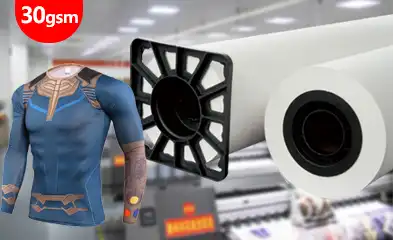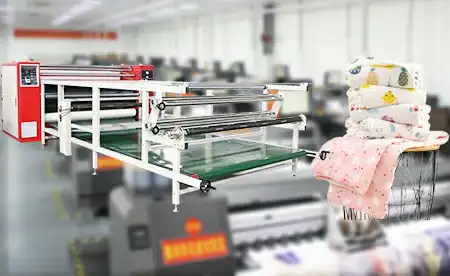HOT SALE
APPLICATION
Phone:+86-15215969856 E-Mail: 396838165@qq.com
Sublimation printing has grown into a popular choice for creating bright, durable designs on T-shirts and other clothing items. At the heart of this technique lies the use of top-notch sublimation paper, which serves as a bridge to move dye-based inks onto polyester materials. The standard of this paper greatly affects the brightness of colors, the clarity of images, and the lasting power of the print. This piece dives into how picking the best sublimation paper can boost your T-shirt printing game. It also explains why knowing how it works with ink and fabric matters so much.

The Role of Sublimation Paper in the Transfer Process
Sublimation paper is vital in making sure the design moves smoothly and correctly from the printer to the fabric.
What is Sublimation Paper and How It Works
Sublimation paper is a unique material with a special layer that holds sublimation ink until heat and pressure come into play. Once heated, the ink turns into a gas. It then blends with polyester fibers at a tiny level. This creates lasting, colorful pictures that won’t crack or peel as time passes.
Key Components That Influence Transfer Efficiency
A few things decide how well sublimation paper works. These include the quality of the coating, how fast it soaks up ink, the speed of drying, and whether it matches the printer and fabric. A nicely coated paper spreads ink evenly. It also stops smudging or bleeding when the transfer happens.
Differences Between High-Quality and Low-Quality Sublimation Papers
Top-tier sublimation papers have better coating evenness, quicker drying times, and improved ink release features. On the flip side, cheaper papers might cause dull shades, fuzzy edges, or transfers that don’t fully stick. Take the 50gsm Factory Supply High Quality Jumbo Roll Sublimation Paper, for example. It offers a solid transfer rate and great heat transfer results. This shows how better papers can truly lift your print quality.
Interaction Between Sublimation Paper and Sublimation Ink
The teamwork between sublimation paper and ink shapes how bold and tough your final T-shirt design turns out.
How Paper Coating Affects Ink Release
The layer on sublimation paper decides how much ink it can keep before passing it to the fabric. A good layer lets out almost all the soaked-up ink when pressed. This ramps up the color strength. We brought in a cutting-edge coating line from Germany for daily sublimation paper production. Thanks to this tech, Changfa Digital ensures its papers keep top coating standards.
Impact on Color Vibrancy and Print Sharpness
The balance of holding and releasing ink impacts not just how rich the colors look but also how clear the image is. A wide range of colors and bright tones, along with better black coverage from professional sublimation ink after transfer, ensures prints are detailed and deep when paired with the right paper.
The Importance of Ink Absorption and Release Rate
If the paper soaks up ink too slowly or unevenly, it can lead to ghosting or faded prints. Quick-dry papers tackle these problems by trapping ink fast. Yet, they still let it go smoothly during heat pressing.
Factors That Affect T-Shirt Print Quality
Aside from the paper’s quality, other surroundings and material factors play a role in the final print outcome.
Fabric Type Compatibility with Sublimation Transfers
Sublimation shines on polyester or polyester-coated materials. Natural stuff like cotton doesn’t bond well with the dye gases. After transfer, textiles show a Sunproof Level of 6 and a Washproof Level of 4-5. These results usually happen only with fitting synthetic fabrics, like those from Changfa Digital.
Temperature and Pressure Settings During Heat Pressing
Wrong heat or pressure levels can mess up prints, leaving them underdone or burnt. Most transfers need about 200°C (392°F) for 30 to 60 seconds, based on how thick the material is.
Moisture Control and Its Effect on Final Output
Water stuck in fabric or paper can cause steam spots or pale patches after pressing. Heating up garments beforehand helps get rid of dampness before you apply the transfer.

Choosing the Right Sublimation Paper for T-Shirts
Picking the perfect sublimation paper made for clothing prints is key to getting pro-level results.
Weight and Thickness Considerations
The weight of the paper affects how easy it is to handle, how fast it dries, and how well the transfer goes.
Light vs. Heavyweight Papers for Garments
Light options, like 29gsm to 40gsm, suit fast-paced production since they dry quickly. But they need gentle handling. Heavier ones, from 70gsm to 100gsm, stay steady during pressing but take more time to dry. Our main products include 29gsm, 35gsm, 40gsm, 50gsm, 60gsm, 70gsm, 90gsm, and 100gsm.
Fast-Dry vs. Regular-Dry Papers: Pros and Cons
Fast-dry papers cut down the chance of smears. However, they might lose a bit of color depth if the ink isn’t a good match. Take the 60gsm Fast Dry Sublimation Paper Roll for polyester fabric. It has a nice transfer rate and solid heat transfer results. Regular-dry papers might give deeper shades, but they need extra drying time before pressing.
Recommended Specifications for T-Shirt Printing
For the best outcome on clothing, Changfa Digital suggests using papers between 60gsm and 90gsm. These strike a good balance between print quality and ease of use across various machines.
Common Issues Caused by Subpar Sublimation Paper
Going with low-grade sublimation paper can mess up every step of your printing process.
Blurred or Faded Prints
Bad coating causes uneven ink spread. This leads to designs that look washed out and lack brightness, even if you press them right.
Ghosting and Color Bleeding Problems
Ghosting happens when transfers move during pressing. This often comes from slow-drying surfaces or poor alignment. It results in double images or messy edges.
Uneven Transfers and Incomplete Images
Cheap base materials might bend under heat. This causes uneven contact between the press and the garment. As a result, some parts of your design don’t transfer at all.
Enhancing Print Quality Through Proper Workflow Practices
Even the best materials need the right steps to keep results steady across different batches.
Pre-Press Preparation Techniques
Preheating the Fabric to Eliminate Moisture
Always warm up garments before adding transfers. This removes leftover dampness that could ruin prints under heat and pressure.
Securing the Transfer to Prevent Shifting
Use heat-safe tape or a light spray of adhesive around the edges. This stops movement during pressing, which often causes ghosting issues.
Post-Press Handling Tips to Preserve Print Longevity
Let printed clothes cool down fully before folding or packing them. This avoids cracks along fold lines as the ink settles into the fabric after transfer.
Introduction to Changfa Digital as a Trusted Supplier
When looking for high-quality supplies for your sublimation printing work, Changfa Digital shines as a top maker. They offer complete solutions, from raw paper production to digital printing services. Their products reach over 120 containers monthly worldwide. Changfa Digital has been a pro sublimation paper manufacturer and digital printing service provider for over 15 years. It’s the go-to factory for sublimation papers.
Overview of Changfa Digital’s Product Lineup
Sublimation Paper Options for Various Applications
Key products include rolls from 40gsm to 100gsm, with widths from 61cm to 190cm. These work for everything from trendy clothes to home fabrics. We provide all types of sublimation paper manufacturing and digital printing services.
High-Performance Printers and Inks for Professional Use
With great flow and 360dpi printing for 20 meters without stopping, their thick inks pair well with Epson I3200 nozzles in business settings. They use eco-friendly solvents that are safe and non-toxic.
Heat Transfer Machines and Tissue Papers for Complete Solutions
Extra tools like Tissue Paper or protective papers (30GSM white/gray) keep transfers clean without dirtying press plates. Tissue Paper/Protect Paper: Weight(gsm): 30GSM (White/Grey).

Conclusion: Maximizing T-Shirt Quality with the Right Sublimation Paper
By thoughtfully choosing the right paper weight for your needs and pairing it with matching inks, you can get amazing results every time. Add in steady habits like controlling moisture and preheating, and you’re set for success. Changfa Digital offers pro-level options made just for clothing decoration markets around the world. Knowing how each part works together in this system gives you better control over the final look. This makes top-notch results possible, even when producing in large amounts.
FAQs:
Q1: What type of sublimation paper is best for cotton t-shirts?
A: Regular sublimation doesn’t do well on cotton because the dyes only stick to polyester fibers. For cotton tees, try DTF (Direct-to-Film) methods instead. These use special films, not the usual sublimation papers meant for synthetics like polyester. Used For: DTF Printer.
Q2: Can I reuse sublimation paper after one transfer?
A: No, you can’t. Once heat is used during a transfer, most of the dye leaves the coated surface. Reusing it will give weak or spotty images, no matter what fabric you use next.
Q3: Why does my print look dull before pressing?
A: That’s normal! Sublimation inks seem pale when first printed on transfer sheets since they’re still solid. The real brightness shows up only after heat turns them into gas. This lets them sink fully into fabric fibers. After a high temperature of 35 degrees, test printing for a long time at a low temperature of 6-8 degrees.







